Hanne Bergius (born in 1947 in Herzberg) is a German art historian and Professor for Art History with emphases on art, photography, modern design and architecture.
Hanne Bergius (born in 1947 in Herzberg) is a German art historian and Professor for Art History with emphases on art, photography, modern design and architecture.
Hanne Bergius studied art history, classical archaeology, and psychology at the Freie Universität Berlin. Her doctoral dissertation on the history and concept of Berlin Dadaism at the FU Berlin was accepted in 1984. In 1990, she received a German Research Foundation grant to investigate the relationship between tradition and modernism in the example of the New Objectivity movement. Then, in 1992, she presented her habilitation project on the concept of montage to the History Department at the FU Berlin and received the Venia legendi for Modern Art History.
She first applied her research results on Classical Modernism in her work as co-curator at the international exhibitions and the catalogs Tendenzen der zwanziger Jahre. Dada in Europa – Dokumente und Werke (15th European Art Exhibition, Berlin 1977) (Tendencies of the 1920s. Dada in Europe) and Paris-Berlin. Übereinstimmungen und Gegensätze Frankreich – Deutschland 1900-1933 (Centre Pompidou, Paris 1978) (Concordances and contrasts France – Germany 1900-1933). After these exhibitions, she advanced her research and, at the same time, continued bringing up her daughters (born in 1969 and 1973).
Bergius gained teaching experience in 1980 with a 9-year teaching appointment in the Architecture Department at the Technical University Dortmund; from 1987 to 1989 at the Kunstakademie Düsseldorf; and in 1990 through her participation in the Radio College Modern Art. After her habilitation, she taught from 1992 to 1994 as a Professor for Art History at the University of Applied Sciences Münster. From 1994 to 2007, she held a Professorship for the History of Art, Design, and Architecture at the Burg Giebichenstein University of Art and Design [1] Her teaching concentrated on the interdependencies among the arts and on aesthetic transfer processes – for example, between Europe and Asia – to make students aware of the scope for interpretations between forms, functions, and levels of meaning in their international cultural and social-historical contexts. The point was both gaining theoretical knowledge and a path to designing and acting.
Bergius' research emphases lie in 19th- and 20th-century Modern art. In numerous scholarly publications since 1975, [2] she has investigated how innovative processes of design and reception develop in their socio-cultural contexts and how they become prevalent against traditional certainties. The international Dada movement, especially Berlin's Dadaism, [3] is one of her primary research areas. [4]
Bergius' monograph Das Lachen Dadas (Dada's laughter), published in 1989, is about the experimental concepts of the grotesque in the Berlin Club Dada and the various projects and performances of the new type of artist, the Da-Dandy, who, in the intersection of current events, calls simultaneously for a radical revision of the arts and for bitingly satirical social criticism. In Montage und Metamechanik (2000) Bergius analyzes Dada's products – the avant-garde process of collages, assemblages, and above all photomontages and their polar field of tension with the works of the metamechanical-abstract phase, which she interprets in terms of Friedrich Nietzsche's complex influence on the Dada concept. With the expanded American publication Dada triumphs. Dada Berlin 1917-1923 (2003), as well as with essays and documentations in Dada: The Coordinates of cultural Politics (1996) and Dada and the Press (2004) she took part in Crisis and the Arts. The History of Dada, edited by Stephen C. Forster (University of Iowa). Beyond that, in 1997, Bergius participated in the international symposium Nietzsche and An Architecture of Our Minds with a paper on the deconstructive architectures of Johannes Baader and Kurt Schwitters and headed a section titled Nietzsche as prophet of Modernism, organized by The Getty Research Institute for The History of Arts and the Humanities.
She also devoted studies to such artists as Jefim Golyscheff, George Grosz, Raoul Hausmann, John Heartfield, Wieland Herzfelde, Hannah Höch, [5] Richard Huelsenbeck, Walter Mehring, Rudolf Schlichter, Erwin Blumenfeld, Paul Citroen, Otto Dix, and Max Ernst, comprehensively reconstructing their contributions to the First International Dada Fair (1920). [6] In 1976, feminist art historiography drew her attention to Gender Studies work on Hannah Höch and other Dadaists. She has been credited with producing the first feminist reading of the work of Hannah Höch and producing "the most exhaustive identification" of Cut with the Kitchen Knife Dada . [7]
In particular, in 2011, [8] Bergius investigated the early Paris work phase of the filmmaker and artist Ulrike Ottinger and, in 2013 at the exhibition Weltbilder (World images), she demonstrated the proximity of Ottinger's ethno- and mythopoetic pictorial concept to Aby Warburg's cultural-scientific research on the transformations of pictorial memory. Bergius’ interest concentrated also on investigations of concepts of montage that developed in the reception of Dada and Surrealism since the 1960s in the areas of Fluxus, Lettrism, the Situationist International, Pop Art, and today’s pictorial production.

Dada or Dadaism was an art movement of the European avant-garde in the early 20th century, with early centres in Zürich, Switzerland, at the Cabaret Voltaire. New York Dada began c. 1915, and after 1920 Dada flourished in Paris. Dadaist activities lasted until the mid 1920s.
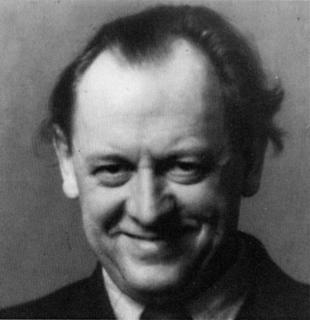
Kurt Hermann Eduard Karl Julius Schwitters was a German artist who was born in Hanover, Germany.

Photomontage is the process and the result of making a composite photograph by cutting, gluing, rearranging and overlapping two or more photographs into a new image. Sometimes the resulting composite image is photographed so that the final image may appear as a seamless physical print. A similar method, although one that does not use film, is realized today through image-editing software. This latter technique is referred to by professionals as "compositing", and in casual usage is often called "photoshopping". A composite of related photographs to extend a view of a single scene or subject would not be labeled as a montage, but instead a stitched image or a digital image mosaic.

John Heartfield was a German political activist and visual artist. Some of his most famous photomontages were anti-Nazi and anti-fascist statements. Heartfield also created book jackets for book authors, such as Upton Sinclair, as well as stage sets for contemporary playwrights, such as Bertolt Brecht and Erwin Piscator.

George Grosz was a German artist known especially for his caricatural drawings and paintings of Berlin life in the 1920s. He was a prominent member of the Berlin Dada and New Objectivity groups during the Weimar Republic. He immigrated to the United States in 1933, and became a naturalized citizen in 1938. Abandoning the style and subject matter of his earlier work, he exhibited regularly and taught for many years at the Art Students League of New York. In 1959 he returned to Berlin, where he died shortly afterwards.
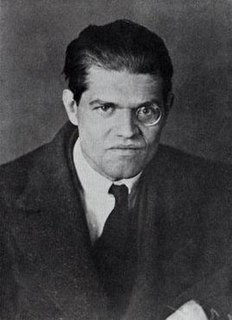
Raoul Hausmann was an Austrian artist and writer. One of the key figures in Berlin Dada, his experimental photographic collages, sound poetry, and institutional critiques would have a profound influence on the European Avant-Garde in the aftermath of World War I.

Hannah Höch was a German Dada artist. She is best known for her work of the Weimar period, when she was one of the originators of photomontage. Photomontage, or fotomontage, is a type of collage in which the pasted items are actual photographs, or photographic reproductions pulled from the press and other widely produced media.

Johannes Baader, originally trained as an architect, was a German writer and artist associated with Dada in Berlin.

Ulrike Ottinger is a German filmmaker and photographer.
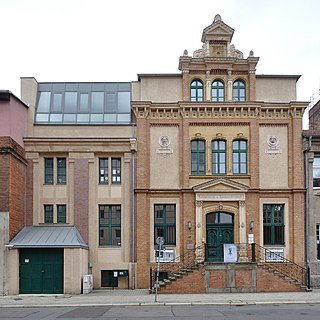
A Kunstgewerbeschule was a type of vocational arts school that existed in German-speaking countries from the mid-19th century. The term Werkkunstschule was also used for these schools. From the 1920s and after World War II, most of them either merged into universities or closed, although some continued until the 1970s.
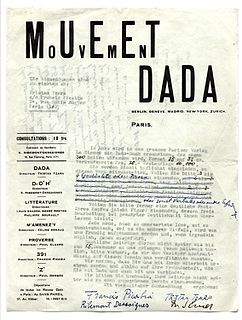
Dadaglobe was an anthology of the Dada movement slated for publication in 1921, but abandoned for financial and other reasons and never published. At 160 pages with over a hundred reproductions of artworks and over a hundred texts by some fifty artists in ten countries, Dadaglobe was to have documented Dada's apogee as an artistic and literary movement of international breadth. Edited by Dada co-founder Tristan Tzara (1896-1963) in Paris, Dadaglobe was not conceived as a summary of the movement since its founding in 1916, but rather meant to be a snapshot of its expanded incarnation at war's end. Not merely a vehicle for existing works, the project functioned as one of Dada's most generative catalysts for the production of new works.

Hans Wittwer was a Swiss architect who worked in Germany and who taught architecture at the Bauhaus art school in Dessau. He was a proponent of functionalist architecture; the idea that form follows function. He worked with the Bauhaus director Hannes Meyer both at the school and in a joint architectural practice in Basel. He also taught at the Kunstgewerbeschule Burg Giebichenstein in Halle.
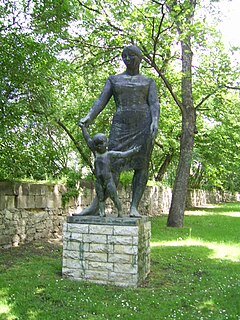
Gerhard Lichtenfeld was a German sculptor and academic teacher, whose works were installed in public space in the Halle (Saale) and Merseburg districts, and who exhibited internationally. He was awarded the Handel Prize.

Burg Giebichenstein Kunsthochschule Halle (BURG) is the university of art and design in Halle an der Saale that was established in 1915. With a student body numbering over 1,000, BURG is one of the largest universities of art and design in Germany. It offers 20 art and design degree programmes in two faculties.
Alice Lex-Nerlinger was a German mid-century artist in the media of painting, photography, photomontage and photograms.
Una Helga Moehrke is a German visual artist specializing in painting, drawing, performance art and experimental text. She was a Professor for Art and Art Mediation at Burg Giebichenstein University of Art and Design in Halle from 1994 to 2018.

Peter Heinz Feist was a German art historian.
Rudolf Heinrich was a German stage designer.
Kathrin Hoffmann-Curtius is a German, independent art historian, who taught for a time at the universities of Tübingen, Hamburg, Trier and Vienna.

Paul Thiersch was a German architect and designer.